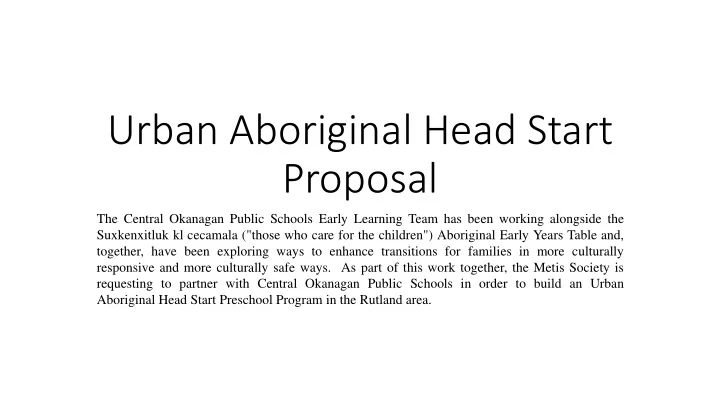

Urban Aboriginal Head Start Proposal The Central Okanagan Public Schools Early Learning Team has been working alongside the Suxkenxitluk kl cecamala ("those who care for the children") Aboriginal Early Years Table and, together, have been exploring ways to enhance transitions for families in more culturally responsive and more culturally safe ways. As part of this work together, the Metis Society is requesting to partner with Central Okanagan Public Schools in order to build an Urban Aboriginal Head Start Preschool Program in the Rutland area.
What is Aboriginal Head Start? The Aboriginal Head Start in Urban and Northern Communities (AHSUNC) Program created in 1995 is a national community-based early intervention program. Indigenous community organizations design and deliver holistic programs to enhance the spiritual, emotional, physical and social wellbeing of Indigenous children aged 0- 6 and their families while supporting their parents and guardians as their primary teachers.
Who Attends AHS • The program targets three distinct groups of Indigenous people living in urban and northern communities: First Nations, Métis and Inuit. • In recent years, the program reach has ranged from 4600-4800 children annually at 134 sites across Canada. • AHSUNC sites typically provide programs for Indigenous children (3-5 years of age) focused on six program components: Indigenous culture and language; education and school readiness; health promotion; nutrition; social support; and parental involvement. • These are intended to work holistically to support Indigenous children’s early childhood development and well-being, and prepare them for a successful transition to school.
How Are AHS Designed • AHSUNC is based on a grass roots, bottom-up approach, where the sites and communities have control over the design in order to best reflect their local culture and needs. • The AHSUNC Projects are free of charge to participants and are typically centre-based preschool programs, running between September and June. • Some sites additionally offer summer programs and/or child care for infants and toddlers. Preschools are licensed by their provincial/territorial jurisdiction and maintain the correct number of certified early childhood educators and ratios of teachers to children. • Educators provide structured early childhood development activities, as well as nutritious snacks and/or daily meals to the children
How Are AHS Designed • In addition to centre-based programming, there are a number of other models used within the AHSUNC programs. • Some sites offer a home visiting component, whereby project staff visit families in their homes, providing information and support to parents, and educational activities for children. • Others include workshops and skill development sessions for parents, joint parent and child workshops and special cultural events and activities for families
Why is AHS Needed? • Why is AHS needed? The 2017 national evaluation of AHSUNC found that there is a continued need for culturally appropriate and holistic early childhood education programming in off-reserve urban and Northern communities. • The AHSUNC program is necessary for four key reasons: 1. the increase in Indigenous people in Canada living off-reserve; 2. as protection against poor socioeconomic effects; 3. the importance of early childhood development on future education success; 4. the need for culturally appropriate and holistic programming that better meets the specific needs of Indigenous children.
Why are Springvalley Elementary and South Rutland Elementary Schools being considered? Both South Rutland Elementary and Springvalley Elementary meet criteria for accessibility, community need, as well as, site/facility space: RUTLAND AREA # # Nominal Capacity (see ELEMENTARY SCHOOLS Aboriginal available Appendix D – Enrolment students in classroom Projections) attendance s Belgo 40 0 slightly over capacity Black Mountain 47 0 over capacity Ellison 21 2 slightly under capacity Pearson Road 31 1 under capacity Quigley 71 2 at capacity Rutland 48 0 over capacity South Rutland 44 2 under capacity Springvalley 76 1 under capacity NOTE: Quigley Elementary and Pearson Road Elementary already have programs being offered that serve Aboriginal families. Ellison Elementary is not as accessible to families in Rutland who rely on Public Transportation.
Urban Aboriginal Head Start Preschool How might an Urban Aboriginal Head Start Program support the needs of children and families in the Rutland area? In our school community?
NEXT STEPS: After consulting with both school communities, staff will make a recommendation for placement of the program. This will happen at the Planning & Facilities Committee Meeting on November 21 st . If supported the recommendation would then go forward to a Board of Education Public Meeting for approval. The Métis Society would submit their proposal for a funding grant. If successful a double wide portable would be placed on site using the capital grant funds. Targeted date for program opening: September 2020.
Recommend
More recommend